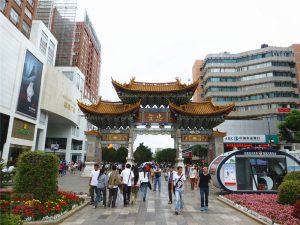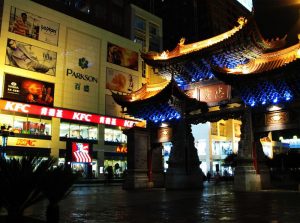
Zhongaifang Archway in Kunming

Chinese Name: 昆明忠爱坊
Chinese Pinyin: Kunming Zhongai Fang
English Name: Zhongaifang Archway in Kunming
Type: Archway, Cultural & Historical Landmarks
Best Time: All the year aroud
Recommended Visiting Hours: 3o minutes
Opening Hours: All Day
Admission Fee: Free
Location: In the city center plaza in downtown Kunming
The Story behind the Zhongai Archway
The Zhongai Archway or Archway of Loyalty and Love was solemnly standing in the downtown. It was built in early Yuan Dynasty (1280) in memory of Saiyid Ajall Shams Al-Din Umar (1211-1279), a famous Muslim politician of the early Yuan Dynasty, for his excellent administration and his great contribution to the social development and the pacification among the ethnic groups when he was in the office of the governor of Yunnan Province.
Related Events
Saiyid’s Administration in Yunnan
In the tenth year of Zhiyuan period of Yuan Dynasty (1273), Saiyid was appointed as the Governor of Yunnan Province by Emperor Shizu or Kublai Khan when he first established Yunnan Province to get rid of the inappropriate appointment of the provincial administrators and the unstable administration.
After his appointment, he visited and learned from the people who knew Yunnan’s geography and social affairs, drew the map of geography, cities and towns, posts, official farming, military farming and civil farming and places of strategy. He did immediately visit the local gentlemen and scholars for important affairs beneficial to the state and the people in order to make practical decisions and policies when he came to his office next year.

There coexisted three political powers in Yunnan at that time were Mongolian royal power, military power and Dali Duan’s power and the administration right was not unified. Saiyid adjusted the relation between the Mongolian royal officials and the provincial officials and put them together into the provincial government office, set up the local military and administrative organs together under the control of the High Pacification Commissioner’s Office, which was under the direction of provincial government. He changed the Mongolian system of Wanhu (ten Thousand households) and Qianhu (one thousand households) into Lu (Route), Fu (prefecture), Zhou (prefecture) and Xian (county) and gave the names in accordance with other provinces.
Since then, all the policies were delivered directly from the provincial government, thus the centralization control of the Mongolian Royal Administration over Yunnan was strengthened. The provincial government office was moved to Kunming from Dali and then Kunming replaced Dali as the political, economic and cultural centre of the whole province ever since.
Saiyid’s Pacification Policy to the Ethnic Hereditary Headmen
For the local upper class, Saiyid took the policy of winning the support of the people instead of military suppression. The new 37 routes followed the 37 tribes of Dali Kingdom and tried to select the local chiefs and local ethnic hereditary headmen as the officials under the route level.
When the local ethnic hereditary headman of Luopandian (Yuanjiang area of Yunnan today) launched a rebel and Saiyid adhered to the pacification policy and had the chief surrendered together with his followers. Thereafter, the local ethnic hereditary headmen of Cheli Baiyi (Xishuangbanna), Heni (Mojiang today) and Jinchi Tribe also submit to the government. For those who falsely accused against him, he comforted them instead of punishment and appointed them to be officials. He would entertain the visiting chiefs with banquet on honour and present them gifts including clothes, hats, shoes and socks and so on. By doing in such a manner he earned the support from the local ethnic hereditary headmen.
Saiyid’s Series of Measures to People’s Life and Production
Saiyid took a series of measures to stabilise the people’s livelihood and develop the production, such as balancing taxation, reducing the corvee, setting up public granary to relieve the victims of natural calamity, setting charitable houses to help the poor. He also called the exiles to go for production.

With the assistance of Zhang Daoli who was the agriculture development commissioner of Dali area, he taught the advanced techniques (of central China) for rice plantation and mulberry and jute growing, helped the Cuan tribes and Bo tribes improve the skills for raising silkworms and mulberry production to double the profits. He vigorously implemented the farming development in Dianchi Lake and Erhai Lake areas as the key farming besides the state farming and military farming. In addition, during his governorship the government also gave the land for the civil farming and even lent common people the buffalos, seeds and farming tools.
There were frequent flood disasters in the Dianchi Lake area of Kunming, and Saiyid launched to dredge the six rivers above the lake and built the Yanwei Dam and the Nanba Dam on the rivers and built the Songhuaba Dam on the Panlongjiang River. He ordered Zhang Lidao to lead 2,000 people to dredge and widen the exit river of the Dianchi Lake to drain out the water in order to relieve the water flood and improve the irrigation, which resulted in great increase of thousand hectares of new farmland.
Saiyid Promoted Communication, Economy and Education
He opened the post roads, built the post houses, prospered the markets, lowered the tax, and encouraged to use currency in order to promote the good exchange and economic change among the ethnic groups.
Though Saiyid was a Muslim, he ruled Yunnan according to the feudal culture inherent in China, Nanzhao and Dali. He first set up supervisors of Confucian schools in Kunming and Dali. In Kunming, besides building the Confucian Temple, schools and dormitories, he set up school lands, and selected children from official and rich families to the schools for study.
Saiyid passed away in 1279 at his post of Yunnan Governor at the age of 68. The historical documents described that his 6 years’ rule of Yunnan started a new administration in the province making a great contribution to the unification of the country, especially the development of Yunnan. He was retrospectively honoured as Prince Xianyang after his death and Yunnan people built a temple and the Zhongai archway in memory of him. His sons and grandsons were appointed as the governors of Yunnan in the Yuan Dynasty and his name Saiyid Ajall became the sign of the family.
His Introduce Islam to Yunnan
A large number of Muslims came to Yunnan after Saiyid was appointed to be the governor of Yunnan, which made the source of Hui ethnic groups in Yunnan and Islam introduced to Yunnan because historical records said that Saiyid was the descendent of Mohammed the father of Islam. He had many mosques built in Kunming, Dali, Lin’an, Ludian and many other places. It was said that he built twelve Mosques in Kunming among of which the well known are the Chengna Mosque at Zhengyi Road and the Yongning Mosque at Jinbi Road.
Related Arches
There are two huge arches on Jinma Biji square: Golden Horse Arch in the east and Jade Rooster in the west.
The Eastern arch in the direction of Mount Jinma is called Jinma Archway; the Western arch in the direction of Mount Biji is called Biji Archway. Together with the northern “Zhong-Ai Gate”, in memory of Sayyid who was a famous politician in Yuan Dynasty(1271—1368), they are known as the “Pinzi Sanfang”: three gates forming the shape of the Chinese character pin, a triangular layout composed of three rectangular forms. A major landmark in central Kunming, it contrasts with the Nanzhao Kingdom Eastern and Western Pagodas, which still stand in south Kunming, representative of the architecture of a more ancient Kunming civilization.
Nearby Attraction
Jingxing Flowers and Birds Market: Located at Yongdao Street (甬道街), Jingxing Flowers and Birds Market was opened for business in 1983, gathering vendors selling flowers, birds, fish and so on, and finally became the biggest flowers and birds market in Kunming. Local people of the city, especially children getting pocket money during the Spring Festival, like wandering around this oldest flowers and birds market to buy the merchandise they like or shop with eyes only.
Yuantong Temple: It is one of the oldest Buddhist monasteries in Kunming with a history of more than 1200 years. It is also the largest temple in Kunming.
Kunming Zoo: It’s also called Yuantong Mountain Zoo, located in the Yuantong Mountain, northern section of Qingnian Road, northeast of Kunming city. Founded in 1953, with about 200 kinds of Yunnan specialty animals and rare animals in the world, Kunming zoo is one of the national top ten zoos and seven major zoos in China.
How to Get there?
By Bus
Take Bus No.120, 137, 152 to Zhongaifang Archway Station.
By Subway
Take Subway Line 1 or 2, get off at Dongfeng Square Statin and walk for about 15mins to Zhongaifang Archway Station.
Travel Tips
It is a nice place to go since many fashion shops, fancy shops, restaurants, and health clubs, pubs, pleasure grounds, supermarkets and sight-seeing minibuses cluster in the Golden Horse and Jade Cock Pedestrian Street.

 7 Days GolfingTour
7 Days GolfingTour
 8 Days Group Tour
8 Days Group Tour
 8 Days Yunnan Tour
8 Days Yunnan Tour
 7 Days Shangri La Hiking
7 Days Shangri La Hiking
 11 Days Yunnan Tour
11 Days Yunnan Tour
 6 Days Yuanyang Terraces
6 Days Yuanyang Terraces
 11 Days Yunnan Tour
11 Days Yunnan Tour
 8 Days South Yunnan
8 Days South Yunnan
 7 Days Tea Tour
7 Days Tea Tour
 8 Days Muslim Tour
8 Days Muslim Tour
 12 Days Self-Driving
12 Days Self-Driving
 4 Days Haba Climbing
4 Days Haba Climbing
 Tiger Leaping Gorge
Tiger Leaping Gorge
 Stone Forest
Stone Forest
 Yunnan-Tibet
Yunnan-Tibet
 Hani Rice Terraces
Hani Rice Terraces
 Kunming
Kunming
 Lijiang
Lijiang
 Shangri-la
Shangri-la
 Dali
Dali
 XishuangBanna
XishuangBanna
 Honghe
Honghe
 Kunming
Kunming
 Lijiang
Lijiang
 Shangri-la
Shangri-la
 Yuanyang Rice Terraces
Yuanyang Rice Terraces
 Nujiang
Nujiang
 XishuangBanna
XishuangBanna
 Spring City Golf
Spring City Golf
 Snow Mountain Golf
Snow Mountain Golf
 Stone Mountain Golf
Stone Mountain Golf














